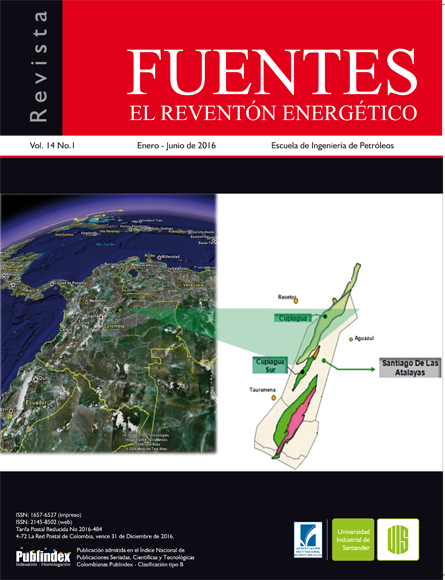
Published 2016-06-24
Keywords
- Heavy Oil,
- SAGD,
- Gravity Drainage,
- Steam Injection,
- Steam Chamber
How to Cite
Abstract
Worldwide, new techniques to implement Enhanced Oil Recovery in heavy oil reservoirs have been studying, since as most of the global reserves are of this type of hydrocarbon. The Steam Assisted Gravity Drainage (SAGD) is a cutting age EOR method that have been applied in bitumen reservoirs gaining successful results, obtaining recoveryfactors up to 50%.
The technique involves two horizontal wells, the first one located a few feet above the second one depending on the viscosity of the crude oil; by the upper well, the continuous vapor injection is made an for density differences this vapor tents to expand to the top of the formation heating the hydrocarbons which then, by gravity come down in the reservoir to be produce, with the condensed vapor, through the second horizontal well. The production mechanism evidenced in this technique is the gravity drainage because in its implementation, applied to bitumen, only the heated hydrocarbons will flow through the producer well by the effect of the gravity therefore a connectivity between the
two wells must be necessary.
However, in the majority of heavy oil reservoirs the crude have mobility i.e. the viscosity is not to high (<10.000 cP), at which the SAGD technique is not effective. This is because in this reservoirs no only the gravitational forces have influence, the viscous forces does to, whereby the injected vapor expands to the overburden, canalizing the vapor, generating energy losses and emulsions formation, causing that the vapor chamber, which is the physical principle of the SAGD, not to form.
This paper presents a comparison of the behavior and develop of the vapor chamber in two different reservoirs with the same characteristics but different type of fluids, the first one is saturated with an extra heavy oil (254814 cP) and the other saturated with a heavy oil with mobility (4019.6 cP) in which the overriding of the vapor in the mobile oil by the effect of the gravitational forces is observed.
Downloads
References
2. BUTLER, R.M. Steam Assisted Gravity Drainage: Concept, Development, Performance and future. JCPT, 1994.
3. CHAKRABARTY C., RENARD G., FOSSEY J., GADELLE C. SAGD Process in the East Senlac Field: From Reservoir Characterization to Field Application. UNITAR Conference, Beijing, China, 1998.
4. CLARK Brian. Heavy Oil, Extra-Heavy Oil and Bitumen Unconventional Oil. NPC Global Oil and Gas Study. Julio 18-2007.
5. DUSSEAULT Maurice. Diplomado en crudos pesados. Modulo V: “Gestión de Proyectos para el Desarrollo de Campos de Crudo Pesado y Nuevas Tecnologías”. Bucaramanga 2008.
6. DUSSEAULT Maurice. Hydrocarbon from NonConventional Sourcer: Heavy and Extra Heavy Oil. Canada: Waterloo University. Cap 2.1.
7. ERIK MONTES & HECTOR PACHECO; “Aplicación de nuevas tecnologías para la recuperación de crudo pesado en yacimientos profundos”; Tesis de grado; UIS 2006
8. GRILLS & VANDAL. Case History: Horizontal well SAGD Technology is Successfully applied to produce Oil at LAK RANCH in Newcastle Wyoming. SPE 78964.
9. GUTIÉRREZ H., DE LA VARA R. Análisis y Diseño de Experimentos. 2° Edición. México, 2008
10. HERNÁNDEZ SAMPIERI, R y otros. Metodología de la investigación. Cuarta edición. 2006.
11. HUMBERTO A. MENDOZA, JOSE J. FINOL & ROGER M. Butler. “SAGD, Pilot Test in Venezuela”; SPE – 53687.
12.MERCADO C, ROSENDO M. “Recobro Mejorado de Crudos en Pozos Horizontales mediante el Método de Segregación Gravitacional Asistida por Vapor utilizando un solo pozo (SWSAGD). Tesis de grado. UIS. 2001.
13.SANDOVAL R., JIMENEZ R. “Nuevas Tecnologías para la Explotación de Yacimientos de Crudo Pesado”. Informe de Investigación. Grupo de Investigación Recobro Mejorado (GRM). 2005.
14.SINGHAL, Y. ITO, M. KASRAJE. Screening and Desing criteria for Steam Assisted Gravity Drainage (SAGD) Projects. SPE 50401, 1998.
15.TERRATEK &F PORTILLO; “Mechanical and Thermal Properties of Unconsolidated Sands and Its Applications to the Heavy Oil SAGD Project in the Tia Juana Field, Venezuela”; SPE – 54009.
16.TRIGOS E. Evaluación técnica de la factibilidad de implementar un proceso SAGD en yacimientos de crudo pesado. Universidad Industrial de Santander. 2010.